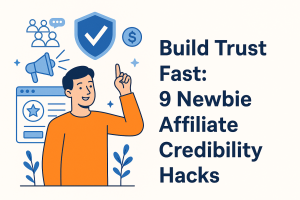Affiliate Credibility Strategies
9 Proven Moves New Affiliates Need for Internet Profit Success

So you’ve decided to jump into affiliate marketing. You’ve got energy, dreams, maybe even a fresh domain name. But here’s the thing: if people don’t trust you, they won’t click your links (or they’ll click, regret it, never come back). That’s why affiliate credibility strategies are your non‑negotiable foundation. Pair that with “Internet Profit Success,” and your brand becomes more than a side hustle, it becomes someone people feel safe following.
Below are nine concrete, super actionable ways to build trust, establish authority, and earn conversions as a newbie affiliate.
1. Be Ethically Transparent (Disclose, Disclose, Disclose)
If you sneak affiliate links in like a malware pop‑up, you’re going to kill trust faster than bad grammar. Transparency is rule #1.
Action: Always include a clear disclosure at the top (or very near the top) of your posts, your emails, your social media captions. Something like: “Heads up: I may earn a small commission if you use one of these links. I only recommend stuff I believe in.”

Why it matters: Transparency = authenticity. Your audience immediately sees you’re not hiding ulterior motives. Disclosing aligns you with FTC guidelines (if you’re in the US), but beyond legality, it signals integrity.
Pro tips:
Use a short disclosure upfront (so people don’t scroll past it) and another reminder at the bottom.
Pair the disclosure with a personal touch: “I only share tools I use myself, here’s why I think X is legit.”
Don’t bury the disclosure in a footer or “terms & conditions” page. That’s like hiding your confession.
This step is one of the purest affiliate credibility strategies, it sets the tone.
2. Promote Only Products You Use & Trust
Nothing kills credibility like recommending garbage tools you never tried. Your audience will sniff that out.
Action: Before promoting anything, test it (if possible), use it, read reviews, compare. Only promote if you genuinely believe in it.
Example: If you're recommending a WordPress plugin, don’t just say “it does X”, say how you used it, what settings you chose, what results you saw. (“I used the auto‑compress feature for my images and cut load time by 20%.”)
Why it works: Authentic endorsements resonate. If someone sees that you had skin in the game, they assume you did your homework. Generic reviews feel like sales pitches; real, lived experience feels like a helpful friend.
Bonus tip: If you can’t test something directly, do deep research: read verified user reviews, contact users, watch demos, or interview someone who’s used it. Use that to color how you present your recommendation (“From what I found, users mention this downside…”).
Guard your reputation: If a promoted product turns out to be dodgy, your trust tank takes damage.
3. Share Honest Reviews: Pros & Cons

If you only sing “hallelujah” for a product, readers assume you’re a shill. Balanced reviews build trust.
Action: Always include at least one downside or limitation in your review. Don’t bury it, call it out. Then explain how to mitigate it (if possible).
Example: “This plugin loads fast and is user‑friendly, but on high‑traffic sites it sometimes causes memory spikes. You can mitigate that by limiting active modules.”
Why: When you show flaws, it shows you’re objective. Readers sense you’re not just trying to sell, but genuinely helping. That’s core to affiliate trust techniques.
Extra layer: After the pros and cons, share comparison to alternatives (“Compared to Plugin Y, this is better on ease of use but weaker on customization”). That frames you as someone doing fair analysis, not just hype.
4. Use Short, Branded Affiliate Links
Ugly, long links full of question marks and parameters? They scream “spam.” Clean links feel safer.
Action: Use link cloaking or redirection tools like Pretty Links, ThirstyAffiliates, or your own domain structure. Example: yourblog.com/go/ToolName.
Why it builds trust: A clean, branded URL looks professional and gives psychological comfort. People are more likely to click something that looks neat and predictable.
Pro tips:
Use 301 redirects so Google sees the link is permanent.
Keep the slug meaningful (e.g. /go/seo‑tool rather than /go/xy23).
Monitor broken or expired affiliate links regularly so you don’t send people to 404s.
Include nofollow or sponsored tags per SEO best practices if required.
When your affiliate link looks like “yourbrand.com/go/Tool,” it speaks to reliability and thoughtfulness.
5. Back Up Claims with Credible Sources
Claims without proof = fluff. If you say “this tool boosted traffic 50%,” back it up with something solid.
Action: Include stats, case studies, studies, or third‑party sources. Even better if you link to them transparently and let your readers examine them.

Example: “User X saw a 50% traffic boost in 3 months using this tool (based on Case Study from Company Z).” Or cite data from an industry report.
Why this adds credibility: Data + citations = authority. You’re not speaking from thin air. You’re showing you did your research. That’s a core component of “affiliate credibility strategies.”
But a caveat: Don’t overdo it. Too many citations or overly academic tone makes the post dry. Use a few strong supporting facts to bolster your core claims. And always verify your sources, don’t pick shady blogs.
6. Create Helpful ‘How-To’ Content
Affiliate posts that just list features = boring sales pages. Tutorials and case studies = relationship builders.
Action: For every tool you promote, create a detailed tutorial showing how to use it, set it up, tweak it, fix common errors. Include screenshots, video snippets, annotated steps. Walk your reader from confusion to clarity.
Example: If you're recommending an email autoresponder, include a step‑by‑step screenshot series: how to set up a template, sequence, automation, typical settings. Then share “here’s how I used it in my funnel.”
Why: People follow you because you solve their problems. They’ll trust you more when you show them how to walk through it. Tutorials show effort, not laziness. It shifts you from “someone selling” to “someone teaching.” That’s a gateway into Internet Profit Success because value leads to trust leads to conversions.
Extra idea: Turn one big tutorial post into multiple micro posts (e.g. “step 1: account setup,” “step 2: list building automation,” etc.). That builds internal SEO opportunities too.
7. Engage & Build Rapport with Your Audience
Trust is relational. The more your audience feels seen and heard, the more they lean in.
Action: Reply to comments, emails, DMs. Ask questions in your posts (“Which tool are you struggling with?”). Use storytelling. Share wins and fails. Occasionally reveal behind-the-scenes.
Why it matters: Engagement humanizes you. If someone sees you responding, that tells them you’re not a faceless product pusher. You care. That reinforces affiliate trust techniques in real life.
Tips:
Set a response goal (within 24‑48 hours).
Use names when replying.
Occasionally run polls or ask feedback.
Highlight user feedback or questions in your next posts (“Someone asked X, here’s how I solved it”).
A community feels safer than a sales funnel.
8. Leverage Social Proof & Testimonials
People trust what other people trust. Harness that.
Action: Showcase real user results, testimonials, screenshots, before/after, quotes (with permission). Use authentic names/photos when possible. If someone gave you feedback by email or DM, ask if you can include a snippet.
Example: “Sarah boosted her blog traffic 50% in 2 months using Tool X. Here’s her screenshot…” And include her direct quote.
Why: Readers see that others are succeeding via your recommended method. It reduces perceived risk. This enhances affiliate credibility strategies because social proof is one of the fastest trust accelerators.
Caution: Don’t fabricate testimonials. That’s dangerous legally and morally. If you’re early stage and don’t have many testimonials, start small, collect feedback from beta users, free trials, or friends. Then slowly build your proof library.
9. Demonstrate Consistency Over Time

Trust doesn’t flash into existence, it accumulates. You earn it day by day.
Action: Stick to a consistent publishing schedule (weekly blog posts, biweekly emails, monthly case studies). Always show up in your niche. Always deliver value.
Example: “Every Tuesday I publish a marketing tip + one affiliate tool insight.” Or “First Thursday of month I send a roundup, always with one tool recommendation.”
Why consistency signals reliability. People are wary of one-off affiliates who appear, spam, and vanish. Showing up regularly says, “I’m here for the long haul.” That’s foundational to affiliate trust techniques.
Extra tip: Keep a content calendar. Repurpose content (e.g. turn a long blog into 3 tweets, one Instagram post, one email). That keeps momentum high without burning you out.
Bonus Section: Integrating Keywords & SEO Best Practices
Since you asked me to be mindful of SEO, here are some tips to ensure your content ranks and your affiliate credibility strategies become discoverable:
Include your main keyword phrase (“affiliate credibility strategies”) in your page title, meta description, first paragraph, and in a couple of headings.
Use related phrases (“build trust as affiliate marketer”, “affiliate trust techniques”) naturally in subheadings and body text.
Use internal linking: link this credibility post to your tool reviews, case studies, or tutorials.
Use external linking: cite strong, high authority sources (industry reports, studies) when backing a claim.
Optimize images (screenshots, infographics) with alt tags that include keyword variations.
Keep paragraphs short (2–4 sentences).
Use bulleted lists to break up walls of text. (You said “plain text,” so I didn’t do fancy HTML, but structure like this still helps readability.)
Use a bit of long-tail SEO: e.g. “best affiliate credibility strategies for beginners,” “how to build trust as new affiliate,” etc.
That way the blog not only helps your audience but also ranks for terms your buyers might search.
Putting It All Together (Summary + Suggested Flow)
Here’s how you might flow the article for best impact (and SEO):
Intro + promise, what the article will teach, include main keyword in first paragraph, mention “Internet Profit Success.”
Why credibility matters, a few paragraphs on the cost of lacking trust, link to affiliate trust techniques.
The 9 credibility moves, each with a heading using or near the main keyword / related phrases.
Bonus tips / integration with SEO & content strategy
Conclusion / call to action, a paragraph summarizing, reminding readers that “trust is a currency,” nudging them to take one small step today.
For more help with affiliate marketing watch these 5 FREE VIDEOS
